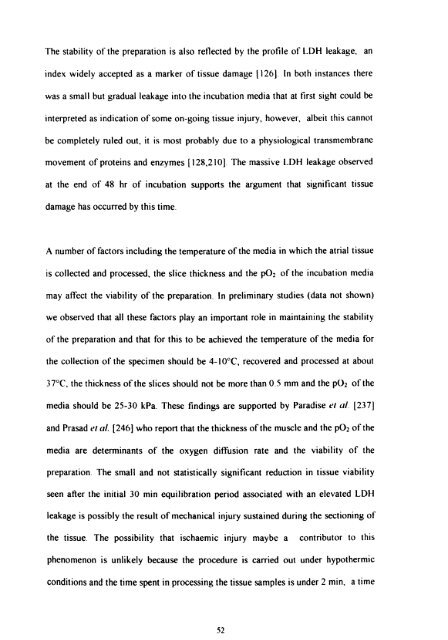ischaemic preconditioning of the human heart. - Leicester Research ...
ischaemic preconditioning of the human heart. - Leicester Research ...
ischaemic preconditioning of the human heart. - Leicester Research ...
Create successful ePaper yourself
Turn your PDF publications into a flip-book with our unique Google optimized e-Paper software.
The stability <strong>of</strong> <strong>the</strong> preparation is also reflected by <strong>the</strong> pr<strong>of</strong>ile <strong>of</strong> LDH leakage, an<br />
index widely accepted as a marker <strong>of</strong> tissue damage 11261. In both instances <strong>the</strong>re<br />
was a small but gradual leakage into <strong>the</strong> incubation media that at first sight could be<br />
interpreted as indication <strong>of</strong> some on-going tissue injury, however, albeit this cannot<br />
be completely ruled out, it is most probably due to a physiological transmembrane<br />
movement <strong>of</strong> proteins and enzymes [ 128,2 101. The massive LDH leakage observed<br />
at <strong>the</strong> end <strong>of</strong> 48 hr <strong>of</strong> incubation supports <strong>the</strong> argument that significant tissue<br />
damage has occurred by this time.<br />
A number <strong>of</strong> factors including <strong>the</strong> temperature <strong>of</strong> <strong>the</strong> media in which <strong>the</strong> atrial tissue<br />
is collected and processed, <strong>the</strong> slice thickness and <strong>the</strong> P02 <strong>of</strong> <strong>the</strong> incubation media<br />
may affect <strong>the</strong> viability <strong>of</strong> <strong>the</strong> preparation. In preliminary studies (data not shown)<br />
we observed that all <strong>the</strong>se factors play an important role in maintaining <strong>the</strong> stability<br />
<strong>of</strong> <strong>the</strong> preparation and that for this to be achieved <strong>the</strong> temperature <strong>of</strong> <strong>the</strong> media for<br />
<strong>the</strong> collection <strong>of</strong> <strong>the</strong> specimen should be 4- 1 O'C, recovered and processed at about<br />
37'C, <strong>the</strong> thickness <strong>of</strong> <strong>the</strong> slices should not be more than 0.5 mm and <strong>the</strong> P02 <strong>of</strong> <strong>the</strong><br />
media should be 25-30 kPa. These findings are supported by Paradise el (It [237]<br />
and Prasad el aL [2461 who report that <strong>the</strong> thickness <strong>of</strong> <strong>the</strong> muscle and <strong>the</strong> P02 <strong>of</strong> <strong>the</strong><br />
media are determinants <strong>of</strong> <strong>the</strong> oxygen diffusion rate and <strong>the</strong> viability <strong>of</strong> <strong>the</strong><br />
preparation. The small and not statistically significant reduction in tissue viability<br />
seen after <strong>the</strong> initial 30 min equilibration period associated with an elevated LDH<br />
leakage is possibly <strong>the</strong> result <strong>of</strong> mechanical injury sustained during <strong>the</strong> sectioning <strong>of</strong><br />
<strong>the</strong> tissue. The possibility that <strong>ischaemic</strong> injury maybe a contributor to this<br />
phenomenon is unlikely because <strong>the</strong> procedure is carried out under hypo<strong>the</strong>rmic<br />
conditions and <strong>the</strong> time spent in processing <strong>the</strong> tissue samples is under 2 min, a time<br />
52














